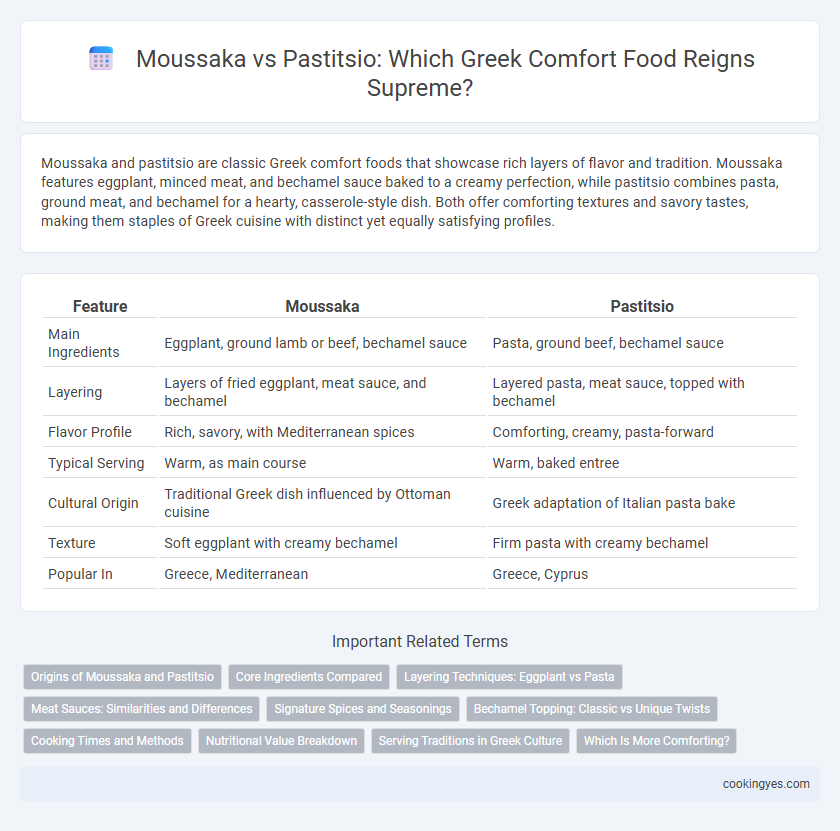Moussaka and pastitsio are classic Greek comfort foods that showcase rich layers of flavor and tradition. Moussaka features eggplant, minced meat, and bechamel sauce baked to a creamy perfection, while pastitsio combines pasta, ground meat, and bechamel for a hearty, casserole-style dish. Both offer comforting textures and savory tastes, making them staples of Greek cuisine with distinct yet equally satisfying profiles.
Table of Comparison
| Feature | Moussaka | Pastitsio |
|---|---|---|
| Main Ingredients | Eggplant, ground lamb or beef, bechamel sauce | Pasta, ground beef, bechamel sauce |
| Layering | Layers of fried eggplant, meat sauce, and bechamel | Layered pasta, meat sauce, topped with bechamel |
| Flavor Profile | Rich, savory, with Mediterranean spices | Comforting, creamy, pasta-forward |
| Typical Serving | Warm, as main course | Warm, baked entree |
| Cultural Origin | Traditional Greek dish influenced by Ottoman cuisine | Greek adaptation of Italian pasta bake |
| Texture | Soft eggplant with creamy bechamel | Firm pasta with creamy bechamel |
| Popular In | Greece, Mediterranean | Greece, Cyprus |
Origins of Moussaka and Pastitsio
Moussaka traces its origins to Ottoman cuisine, evolving into a layered eggplant and meat dish widely embraced in Greek households. Pastitsio, rooted in Italian influences, features pasta baked with bechamel sauce and ground meat, reflecting Mediterranean culinary integration. Both dishes represent distinct yet complementary strands of Greek comfort food heritage.
Core Ingredients Compared
Moussaka features layers of eggplant, spiced ground lamb or beef, and bechamel sauce, creating a rich, creamy texture emblematic of Greek comfort food. Pastitsio uses tubular pasta, ground meat seasoned with cinnamon and nutmeg, and a similar bechamel topping, highlighting its baked pasta casserole roots. Both dishes emphasize ground meat and bechamel but differ significantly in their starch base--eggplant for Moussaka and pasta for Pastitsio--offering unique textures and flavor profiles.
Layering Techniques: Eggplant vs Pasta
Moussaka features expertly layered slices of tender eggplant, creating a rich texture that absorbs the spiced meat sauce and creamy bechamel topping, delivering a distinctive Mediterranean depth. Pastitsio, by contrast, employs layers of al dente pasta interspersed with seasoned ground meat and bechamel, offering a structured, heartier bite commonly associated with Greek comfort food. The choice between eggplant layers in Moussaka and pasta layers in Pastitsio highlights the contrasting textures and foundational ingredients central to their unique culinary identities.
Meat Sauces: Similarities and Differences
Moussaka and pastitsio both feature rich meat sauces made with ground beef or lamb, tomatoes, onions, and aromatic herbs such as cinnamon and oregano, reflecting classic Greek flavors. Moussaka's meat sauce is typically thicker and layered beneath eggplant and bechamel, while pastitsio's sauce often incorporates pasta and is mixed more uniformly with bechamel on top. The subtle difference in seasoning and texture makes moussaka's sauce slightly heartier, whereas pastitsio offers a smoother, baked consistency.
Signature Spices and Seasonings
Moussaka relies on a rich blend of cinnamon, allspice, and nutmeg, infusing the eggplant and meat layers with warm, aromatic depth that defines its signature flavor. Pastitsio features a spiced bechamel sauce seasoned with nutmeg, complemented by oregano and cloves in the ground meat mixture, creating a fragrant, layered taste profile unique to Greek comfort food. Both dishes highlight the traditional Mediterranean spice palette but showcase distinct seasoning blends that set them apart in flavor and aroma.
Bechamel Topping: Classic vs Unique Twists
Moussaka features a rich, creamy bechamel topping traditionally made with butter, flour, and milk, creating a smooth, golden crust that contrasts with layers of eggplant, ground meat, and tomato sauce. Pastitsio's bechamel often incorporates beaten eggs or cheese, like Kefalotyri, for a thicker, custard-like finish that binds pasta and meat layers together. Unique twists on Moussaka's bechamel topping may include adding nutmeg, cinnamon, or Parmesan for extra depth, while Pastitsio variations sometimes infuse bechamel with herbs or substitute milk with cream for richer texture.
Cooking Times and Methods
Moussaka requires slow baking, typically 45-60 minutes, allowing layers of eggplant, ground meat, and bechamel sauce to meld and develop rich flavors, while pastitsio bakes for about 40-50 minutes, emphasizing pasta, meat sauce, and creamy bechamel in a quicker, more structured assembly. Both dishes employ layered techniques, but moussaka involves sauteing eggplants and often frying components before baking, contrasting with pastitsio's use of boiled pasta and a more straightforward layering method. The extended baking of moussaka enhances caramelization and texture, making it a heartier culinary experience compared to the relatively lighter pastitsio.
Nutritional Value Breakdown
Moussaka features layers of eggplant, ground meat, and bechamel sauce, offering a rich source of protein, calcium, and healthy fats, while being moderate in carbohydrates. Pastitsio, composed primarily of pasta, ground meat, tomato sauce, and bechamel, provides higher carbohydrate content along with substantial protein and fat levels. Both dishes deliver essential nutrients but differ in macronutrient balance, with moussaka leaning towards lower carbs and pastitsio offering a more energy-dense profile.
Serving Traditions in Greek Culture
Moussaka is traditionally served in individual portions, often accompanied by a fresh Greek salad and crusty bread, reflecting its status as a hearty, comforting family meal in Greek culture. Pastitsio, on the other hand, is typically baked in a large casserole dish and served in generous slices, ideal for communal dining and festive gatherings. Both dishes highlight the Greek emphasis on sharing food, with moussaka favored for everyday comfort and pastitsio reserved for special occasions.
Which Is More Comforting?
Moussaka, with its rich layers of eggplant, seasoned ground meat, and creamy bechamel sauce, offers a warm, hearty experience that many consider the epitome of Greek comfort food. Pastitsio, featuring tubular pasta baked with spiced meat sauce and bechamel, provides a similarly satisfying but slightly lighter texture and flavor profile. For those seeking ultimate comfort through creamy, savory depth and a melt-in-the-mouth finish, Moussaka often edges out as the more comforting choice.
Moussaka vs pastitsio for Greek comfort food Infographic

 cookingyes.com
cookingyes.com